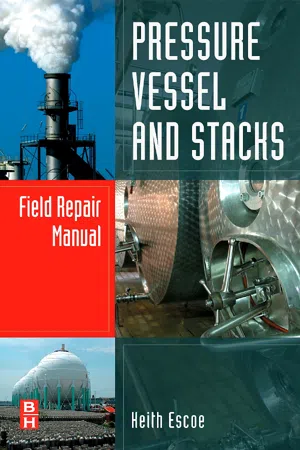
- 208 pages
- English
- ePUB (mobile friendly)
- Available on iOS & Android
Pressure Vessel and Stacks Field Repair Manual
About This Book
Written from the practitioner's perspective, this book is designed as a companion for engineers who are working in the field and faced with various problems related to pressure vessels and stacks, such as: modification, retrofitting existing pressure vessels or stacks to either enhance process capability, lift, move or replace damaged equipment. This makes the book a valuable guide for new engineers who need to develop a feel for these types of operations or more experienced engineers who wish to acquire more useful tips, this handy manual provides the readers with rules of thumbs and tips to mitigate or remediate problems which can occur on a daily bases.
Because of their size, complexity, or hazardous contents, pressure vessels and stacks require the highest level of expertise in determining their fitness for service after these operations. Care must be taken in installation / removal of the vessel to avoid damage to the shell. Damage to the shell can result in catastrophic failure and possible injury to personnel. The book will cover topics such as: lifting and tailing devices; an overview of rigging equipment; safety consideration; inspection and repair tips; methods to avoid dynamic resonance in pressure vessels and stacks; wind loads and how to apply them for various applications and assessment guidelines for column internals, tables and pressure vessel calculations, and code formulas.
The examples in the book are actual field applications based on 40+ years of experience from various parts of the world and are written from a view to enhance field operations. In many parts of the world, often in remote locations, these methods were applied to repair pressure vessels and stacks. These problems will still continue to happen, so there is a need to know how to address them. This book is to present assessments and techniques and methods for the repair of pressure vessels and stacks for field applications. Also the book is to be a repair manual for easy use for mechanical engineers, civil-structural engineers, plant operators, maintenance engineers, plant engineers and inspectors, materials specialists, consultants, and academicians.
- Lifting and tailing devices
- An overview of rigging equipment
- Inspection and repair tips
- Guidelines for column internals
- Tables and pressure vessel calculations, and code formulas
Frequently asked questions
Information
Chapter 1. Systems of Units







Table of contents
- Copyright
- Brief Table of Contents
- Table of Contents
- List of Figures
- List of Tables
- Dedication
- About the Author
- Preface
- Chapter 1. Systems of Units
- BibliographyReferences
- Chapter 2. Handy Pressure Vessel Formulas
- BibliographyReferences
- Chapter 3. Dynamic Response of Pressure Vessels and Stacks
- BibliographyReferences
- Chapter 4. Wind Loadings on Pressure Vessels and Stacks
- BibliographyReferences
- Chapter 5. Pressure Vessel Internal Assessment
- BibliographyReferences
- Chapter 6. Safety Considerations for Lifting and Rigging
- Chapter 7. Lifting and Tailing Devices
- BibliographyReferences
- Chapter 8. Assessing Weld Attachments
- Chapter 9. Rigging Devices
- Index